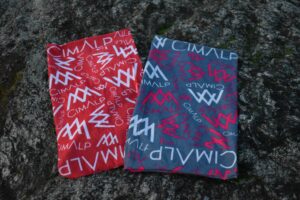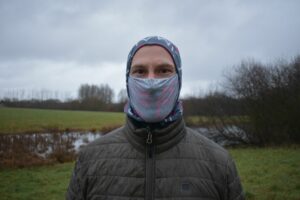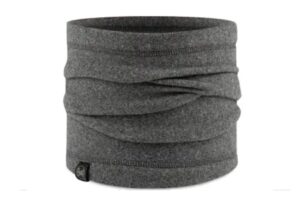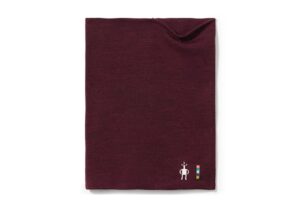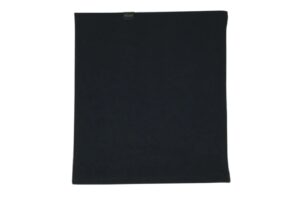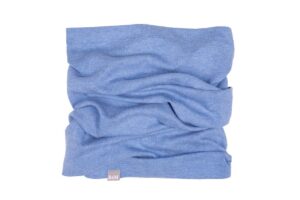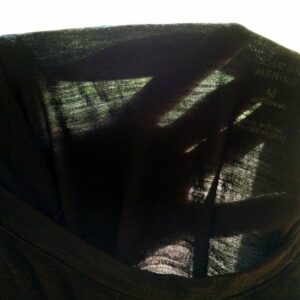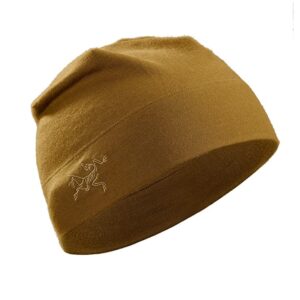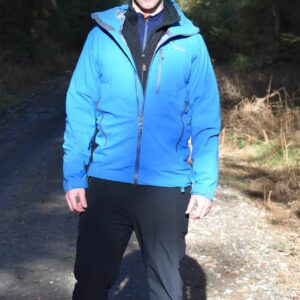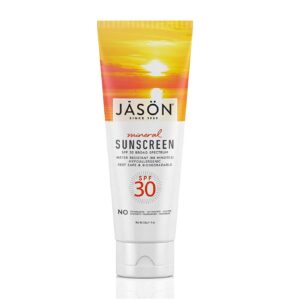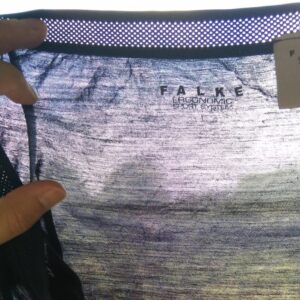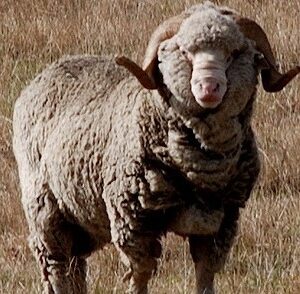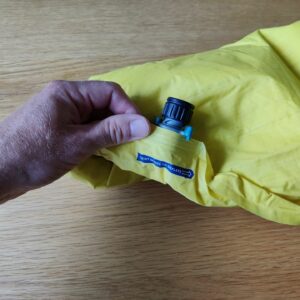I got my first neck gaiter in 2008 as a part of the promotional stuff you get in marathon bags. At first, I didn’t know what the tube-shaped piece of fabric was supposed to be used for but after a little bit of research I figured out that it’s a neck gaiter. I checked how to use it and was impressed with the versatility of the garment. Soon it became one of my most used accessories garments in my sports wardrobe. I now use neck gaiters regularly for hiking, running and even travelling.
A neck gaiter is basically a tube-shaped piece of fabric which, as the name suggests, is typically worn around the neck. However, a neck gaiter can be worn in many ways. For example, you can wear it on your head instead of a beanie or on your arm as a sweatband. Neck gaiters are also called buffs, neck warmers and tubulars. In the following I’ll explain what neck gaiters are used for, what types of neck gaiters exist and the most popular ways to wear a neck gaiter.
Table of contents:
- What are neck gaiters used for?
- Types of neck gaiters
- Most popular ways to wear a neck gaiter
- Conclusion
What are neck gaiters used for?
Neck gaiters keep you warm in winter and provide sun protection in the summer. They are inexpensive, lightweight and take up little space in your backpack. Therefore, they’re perfect for carrying along in any backpack on any adventure.
Winter
The most common ways to wear a neck gaiter in winter are as a scarf, hood, balaclava and a beanie. A neck gaiter provides extra insulation and also some protection against the wind. Neck gaiters are typically made of relatively thin fabrics (with a few exceptions) and thus not a replacement for example for a winter hat. However, the thin fabric also has advantages. It dries very fast which is indeed a good quality, especially for sportwear. Wet clothes make your body lose heat more rapidly. You can read more about wet clothes and body heat loss in my article Why should you wear quick drying clothes for hiking.
I sometimes wear a neck gaiter as a beanie under my winter hat – kind of like a base layer under the mid-layer which in this case would be the hat. The good thing about this setup is that the neck gaiter dries much faster than the winter hat. Furthermore, I can put the winter hat off during high intensity stretches and back on when the intensity decreases.
Summer
In the summer, the neck gaiter can be worn to protect the neck or the head against the sunburns. Neck gaiters made of thin synthetic materials or thin Merino wool, are perfectly suitable for high temperatures. I often wear a neck gaiter around my neck or as a pirate hat in the summer. By wearing a neck gaiter on my shaven head or neck, I also don’t have to fiddle with suncream all the time. That’s especially true at high altitudes where sun cream must be reapplied regularly due to increased UV radiation. If you’re buying a neck gaiter for summer use, I recommend going for a thin neck gaiter and remember to check the UPF rating.
Types of neck gaiters
Neck gaiters differ by type of the material and thickness of the material. The most common material for neck gaiters is polyester. However, over last few years alternative materials such as Merino wool, hemp and bamboo have become increasingly popular.
Polyester Neck Gaiters
Polyester neck gaiters come in many variants, from super thin ones which are suitable for year-round use to those made out of thick fleece material for activities in extreme cold. Most outdoor brands sell some sort of year-round polyester neck gaiters. On the other hand, the American brand Buff has a wide selection of thick polar fleece neck gaiters and knitted neck gaiters which provide superb warmth and are primarily designed for winter use.
Polyester neck gaiters are durable, breathable and dry very fast. We have been very happy with the neck gaiters we got from French brand CimAlp. The downside of polyester neck gaiters is that they quickly become smelly unless they are treated with antimicrobial agent.
Merino Wool Neck Gaiters
Merino wool neck gaiters have become increasingly popular in the last years. Merino wool dries a bit slower than polyester but provides better breathability and odor resistance. Furthermore, Merino wool also retains more heath when it’s wet than polyester. Merino wool neck gaiters can be worn both in warm and cold temperatures because Merino wool can be knit into very thin fabrics. Merino wool neck gaiters can be bought from Isobaa, Buff and Smartwool.
Hemp and Cotton Neck Gaiters
Hemp and cotton neck gaiters are not the best choice for sports activities. These materials absorb a lot of water and thus dry slower than wool or synthetic materials. Nevertheless, hemp and cotton are great materials for everyday wear.
Hemp neck gaiters are typically mixed with cotton because hemp is not soft enough on its own. Hempzoo sells neck gaiters that are made of hemp and organic cotton. Hemp is an environment friendly material because it doesn’t require pesticides or enormous amounts of water to grow as opposed to cotton. It’s also naturally biodegradable. Neck gaiters made of pure cotton can be bought in many stores, including Walmart. These are the cheapest option. However, they do not match any of the other materials in performance and leave a larger environmental footprint.
Bamboo Neck Gaiters
Bamboo neck gaiters are not that common, but I decided to mention them because bamboo is gaining popularity as a fabric. In comparison to polyester, bamboo provides better breathability and is softer to the touch. Bamboo is also naturally antimicrobial just like Merino wool. However, bamboo absorbs more water and thus dries slower. Bamboo neck gaiters are therefore best for light intensity sports. There are only a few brands that have bamboo neck gaiters. BAM is one of the popular ones.
Most Popular Ways to Wear a Neck Gaiter
A neck gaiter can be worn in many ways. Here are some of the popular ones.
Scarf
Put the neck gaiter around your neck to protect it against low temperatures and wind. In summer you can wear a neck gaiter like this for protection against UV radiation.
Neck Warmer
Put the neck gaiter around your neck and pull it over your chin and the back of your neck for extra protection against the cold and the wind.
Hood
Put the neck gaiter around your neck and then pull the back up to cover your head while the front stays under your chin. Wearing a neck gaiter like this is excellent for keeping warm.
Balaclava
Do the same as for the hood but then pull the material from under your chin up. Wearing a neck gaiter like this is best for low temperatures. Nevertheless, you can also wear it like this in summer for protection against the UV radiation.
Beanie
Turn the neck gaiter inside out and place one of the ends on top of your head. Then twist it in the center a few times. Take the opening above the twist and pull it down over your head. This method ensures that two layers of fabric cover your head for good warmth.
Pirate Hat
Grab the neck gaiter at the opposite ends from the inside and then pull outwards. Adjust a little bit and the pirate hat is ready. Wearing a neck gaiter like this is best for sun protection in high temperatures. Only one layer of fabric covers your head and thus the garment doesn’t provide much insulation (depending on the thickness of neck gaiter of course).
Conclusion
A neck gaiter is a very versatile garment. It can be used for protection against heat loss and the wind in the winter and for protection against UV radiation in the summer. Neck gaiters are really inexpensive garments and rarely cost more then $ 30. Therefore, they’re perfect for carrying along in any backpack on any adventure. If you’re buying a neck gaiter for sports (hiking, running etc.) I do recommend buying a polyester or Merino wool neck gaiter. These neck gaiters provide the best performance in terms of breathability, moisture-wicking performance and drying time.
